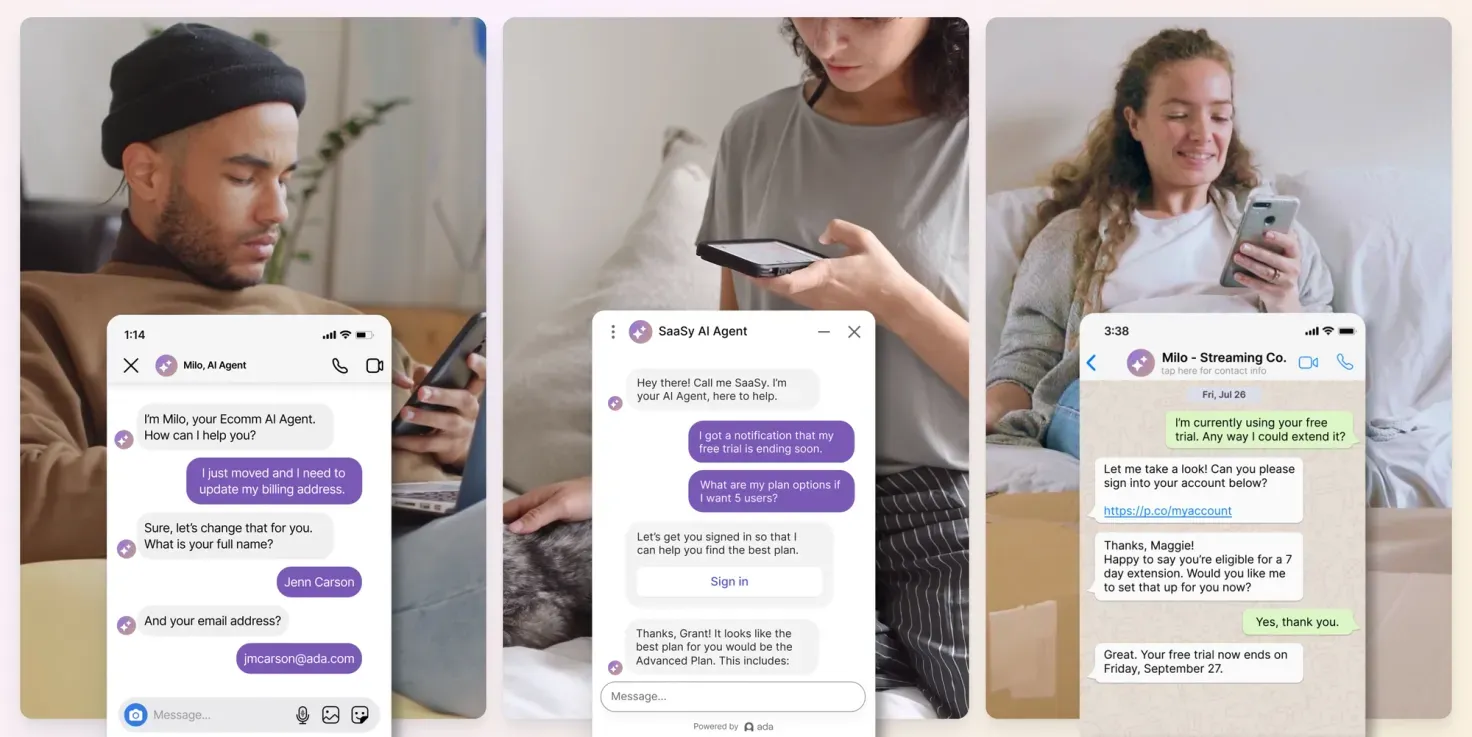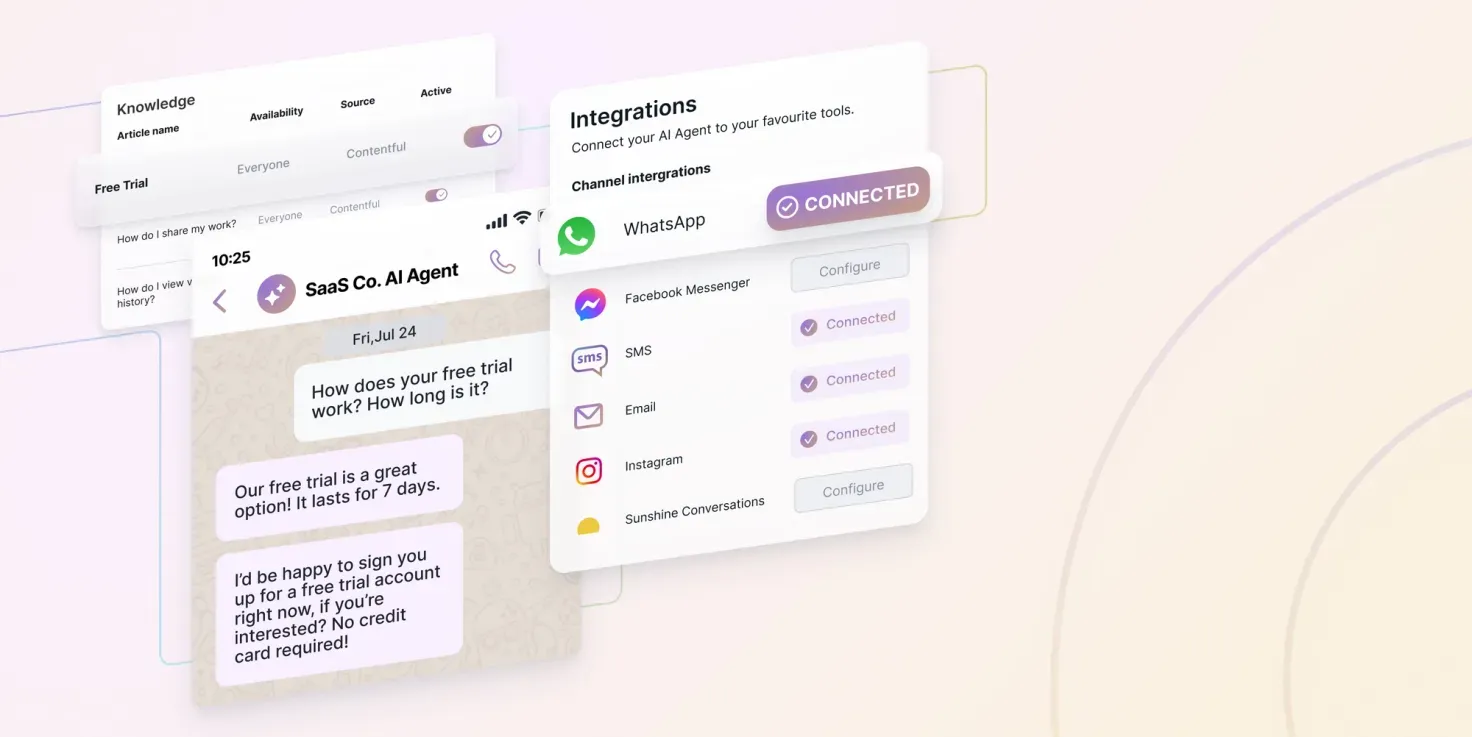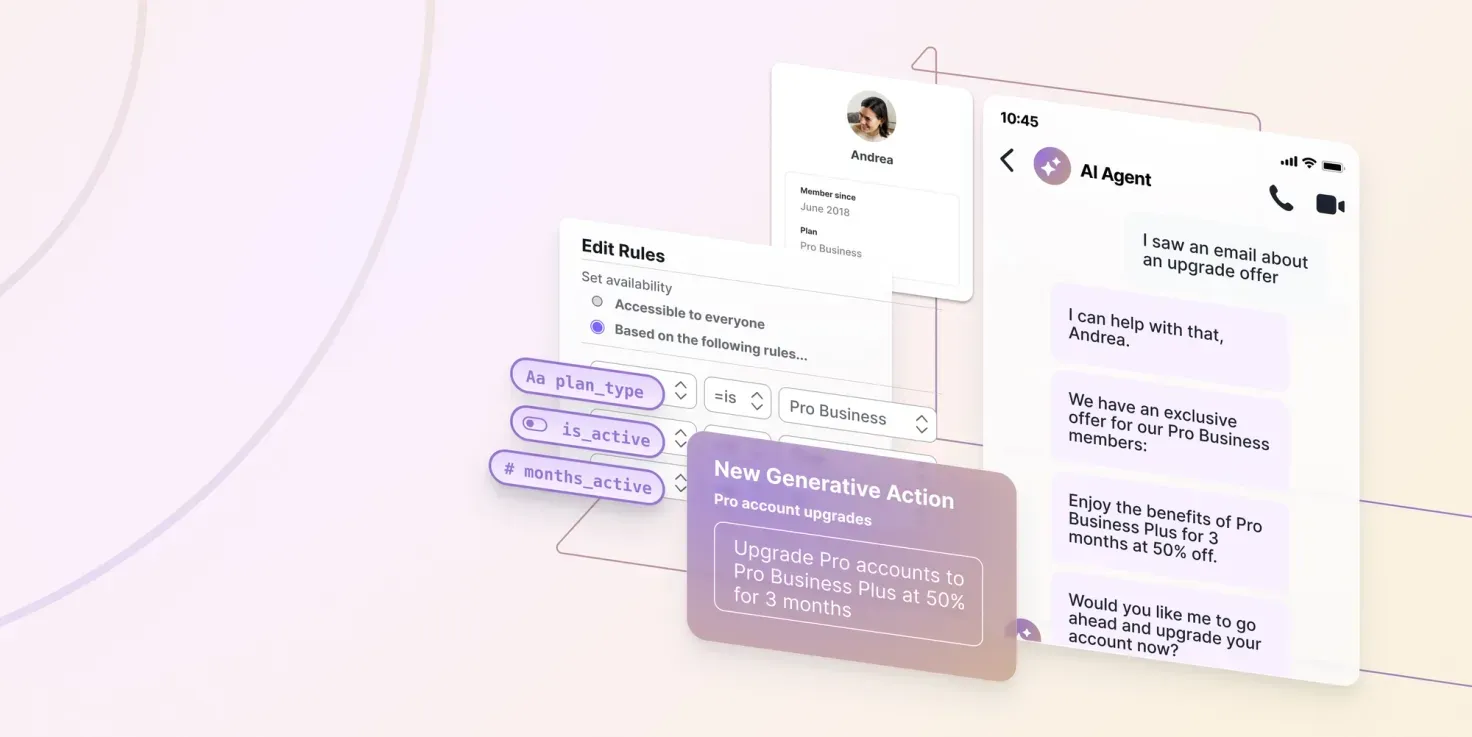
Guide to building vs. buying an AI Agent for customer service
This guide will help you assess the build vs buy question from 5 main angles so you can make a confident, informed decision.
Learn More

Modern customers demand instant, personalized responses across all channels.
Enter generative AI : the game-changer revolutionizing SaaS customer service . This powerful technology isn't just meeting expectations — it's shattering them. Imagine a world where your AI agent effortlessly handles everything from quick account upgrades to complex, personalized onboarding. It's not science fiction, it's happening now.
SaaS businesses are leveraging AI to deliver human-like interactions that solve problems faster and more efficiently than ever before. And in turn, it’s impacting their bottom line; over nine in 10 organizations with AI report cost and time savings.
That's not just an improvement; it's a seismic shift in operational efficiency.
The future of SaaS customer service isn't just automated, it's hyper-personalized, ultra-efficient, and powered by AI. And the best part? It achieves all this with zero operating leverage. Welcome to the new era of customer service, where AI doesn't just meet expectations, it exceeds them, reshaping the very landscape of customer interactions.
Ready to revolutionize your SaaS customer service? Let's dive into everything you need to know about harnessing the power of AI to deliver quality service at an unprecedented scale.
SaaS customer service automation refers to using technology to automate customer service tasks for greater operational efficiency, and more importantly, to improve customer experience.
Customer service automation tools have been around since the ‘90s, but we’ve gone far beyond the basic technology that powers it. With AI, automation tools can now match the level of personalization that human agents offer and deliver real-time responses to customers.

The same reason why we don’t use a rotary phone to order food. Manual customer service is outdated, inefficient, and bad for business. Here’s why:
If you’ve spent enough time observing support teams, it’s easy to see how a combination of speed and personalization demands can act as a bottleneck.
AI automation systems can respond to customer queries in real time, be available 24/7, and offer personalized and immersive experiences that customers crave.
This means automating customer service is mission-critical for SaaS companies that want to minimize churn, maximize Automated Resolution Rate (ARR), and meet customers’ need for instant responses while offering personalized experiences.
Take monday.com for example. Before Ada’s AI Agent, monday.com ’s CX team managed chat, email, and callbacks globally, with 76% of their conversation volume coming in from the chat channel. Unfortunately, their scripted chatbot was hard to maintain and required constant, manual updates. To solve this problem, the team wanted a more dynamic solution that could automatically resolve customer inquiries coming on their chat channel.
With Ada’s AI Agent, monday.com was able to resolve more inquiries and make their highest volume channel their most successful. And it wasn’t long until they promoted Ada’s AI Agent to email .
“The immediate improvements in performance and flexibility with an AI Agent were astonishing. Just turning it on was like 40-45% containment. Everyone was initially shocked and unsure how it could be that good. Through QA, and growing the confidence of the management and team, it’s now much easier for us to make changes and decisions and move forward and develop it.”


Clearly, AI customer service can go beyond increasing CSAT scores and containment — all you need is vivid imagination and Ada’s AI Agent.
Let’s paint a picture of what you can achieve with an AI agent. Imagine this:
These are efforts all SaaS companies need to differentiate CX, make their support team more efficient, and boost their topline figure. The problem? Scaling these efforts requires an army of agents or a powerful AI agent. Take your pick.
Let’s lay some groundwork before we dive into how you can automate customer service. Here are some tools you might need:
These are the essentials, but you may choose to include more tools based on your needs in your toolkit. For example, you may include in your toolkit, such as a ticketing system, helpdesk software, and screen-sharing tools.
The AI agent is your primary automation tool. It’s where a customer’s interaction starts, and if you choose the right AI agent, ends. Let’s look at how you can use the AI agent to automate customer service.
A knowledge base is the backbone of an automated customer service system. It’s your AI agent’s go-to source for queries like “How do I reset my password?” or “How do I get a copy of my last invoice?”
Consider investing in knowledge base software — they’ll make it easier to build and manage your knowledge. Check out our guide on building a knowledge base for customer service for a step-by-step guide.
A knowledge base isn’t just an information database for your AI agent, it’s also a way for customers to self-serve. When building a knowledge base for your AI agent as well as customers who want to self-serve, be mindful of the following basics:

There are dozens of AI agents on the market, but most aren’t worth your while. While most AI agents take a hybrid approach, combining generative AI and traditional workflows, Ada’s AI Agent is the only fully generative, omnichannel customer automation platform. To choose the right agent, here’s what you should look for:
Omnichannel support
An omnichannel AI agent allows you to automate customer service across all channels. It makes sense to use just one tool to manage customer interactions on every channel to prevent app sprawl. Ada’s AI Agent can automate all service channels , including chat, phone, and email.
Integrations
An AI agent should integrate with other tools in your tech stack so it can easily exchange information. For example, when a customer references a previously resolved ticket, your AI agent should be able to look up your ticketing system to get the right information. If the AI agent doesn’t offer an out-of-the-box integrations , make sure it offers APIs so you can build a bespoke solution.
Ability to troubleshoot complex problems
AI agents don’t just need to fetch invoices and answer subscription-related questions. Customers might have more complex questions. For example, they might have questions about a new feature you recently introduced. Your AI agent should be able to answer these questions accurately and hand-hold the customer through the solution. To enable an AI agent to answer complex queries, it needs to be able to look up your knowledge base or have the ability to learn to solve problems based on multi-step instructions provided during training.

Security
Check the level of security your AI agent can deliver . Most vendors worth considering lay down their data practices in detail on their website, including information about their servers, data flow, application security, and privacy compliance. Look for tools compliant with regulations like CCPA, GDPR, and HIPAA and have a SOC 2 certification, penetration test reports, a data flow diagram, and a vulnerability disclosure program.
Your AI agent is like a high-IQ child with zero life experience. It can respond to customer queries only once you coach it.
Feed quality data
The better the data, the sharper your AI agent will be. Using large datasets to train your AI agent is a great idea, but make sure the data is junk-free, diverse, and well-structured to minimize bias and generative AI hallucinations and improve the model’s understanding of tasks.
Consider training the AI agent with real feedback, up-to-date information about your SaaS, and information-rich interactions with actual customers. Include everything from simple questions to highly technical questions that aren’t asked as frequently in your training data. Detox your dataset once it's ready — remove duplicates and outdated, half-baked, or irrelevant information.
Dry-run complex and bizarre scenarios
No AI training is complete until you’ve put it through the winger with the weirdest and most complex scenarios.
For example, if your product is an IoT SaaS, your AI agent should be able to respond to everything from “Can your software communicate with my refrigerator?” to “I’m having trouble getting an automation workflow to trigger when I use an external API call through my backend system. What should I look for in the logs?”
When stress testing the AI agent:
Simulate stress scenarios: Finally, dry-run your AI agent under stress — throw a couple of complex scenarios at it simultaneously. Customers aren’t always patient. When they bombard your AI agent with questions, it needs to be able to provide thorough and accurate responses.
Discover the 8 success criteria that you should be testing AI Agents on to get the most return on your investment.
Get the guideYour AI agent is one cog in a bigger machine. Integrating your AI agent with other tools in your tech stack enables them to exchange data. Here are some examples of tools you can integrate the AI agent with:
Social media tools: Need your AI agent to be your social media rep? Integrate it with social media management tools like Hootsuite and Sprout Social. The AI agent will take care of support inquiries, complaints, and feedback you receive on your social media handles so your customers never have to wait hours before a support agent gets to their case.

AI agents are self-learners. Every interaction makes them sharper, but don’t just let it learn on autopilot. Monitor how it interacts with customers to identify friction points and recurring issues and iron them out.
And remember, your AI agent is a data goldmine. Monitoring its interactions with customers can give you a wealth of insightful information about Automated Resolution , resolution times, customer satisfaction scores (CSAT) , and escalation rates. Use this information to optimize the AI agent’s performance when needed.

What’s the ROI on customer service AI? While the numbers look different for every SaaS company, we explain the benefits you can expect from automating customer service for your SaaS below.
24/7 availability is non-negotiable if you have clients in other time zones. But it’s also necessary because a customer in your timezone might decide to troubleshoot at 3 AM on a Saturday. Meeting a customer’s need for instant access to help builds trust and makes your customers feel valued. The result? Better retention rates and higher satisfaction.
Thankfully, AI agents don’t need sleep or coffee breaks. It’s like having an all-star customer service on call, 24/7, without having to pay overtime or worry about someone actually wanting to work at those ungodly hours.
You’ve probably heard this a million times — customers want faster responses from brands. But how fast exactly? Let’s put this need for speed in context with numbers. Here’s how fast you need to respond over different channels to stay ahead of your competitors:
Can your current customer service team respond consistently at this speed? Mind you, the responses need to be personalized, which means the support agent might have to sift through customer data before responding.
Delivering fast and personalized service at scale round the clock is practically impossible unless you hire hundreds of support agents and pay tons in overtime. An AI agent, on the other hand, can single-handedly take care of all customer demands.
Imagine designing a personalized onboarding experience for new users that includes product walkthroughs based on user behavior and preferences. Once the customer is onboard, you can monitor user activity and offer tailored discounts to users at risk of churning via your AI agent.

The median spend of a SaaS company on customer support and customer success is 8.5% of their ARR . That’s a massive number — for every $100,000 in revenue, SaaS companies spend $8,500 on customer support and customer success.
Can you reduce this cost and boost your bottom line? Yes, according to McKinsey . Using technology, like AI and automation, to revamp CX can reduce costs by 20% to 40%. And it’s easy to see why:
Most SaaS companies have users outside their home country. If the primary language in these countries is not English, multilingual support is critical. Clients in countries like Hungary, Germany, or France might prefer to communicate in their native language.
65% of buyers prefer content in their language, even if it’s poor quality, and 40% won’t buy from companies that don’t use their native language.
- CSA Research
Here’s a wild guess: You probably don’t want to hire a customer service rep for every language your clients prefer to communicate in.
If that’s how you feel, an AI agent can take care of this problem for you. Conversational AI can respond to customers in their preferred language (provided the AI agent supports it) while still delivering the same level of personalization and instant responses it does in English.
Some customer service teams use manual translations to deliver multilingual support via email. But lacking a thorough understanding of the language comes with barriers you can’t overcome. For example, the AI agent can identify opportunities to upsell users on add-ons or a higher tier based on product usage patterns. However, support agents who don’t understand the language are likely to fail to effectively communicate when upselling.
Delivering exceptional service is about more than just real-time responses. Most customer service automation can do that. If you’re looking to deliver experiences that become a competitive advantage, you need a powerful AI agent and a partner that can help you realize its full potential.
At Ada, our mission is to revolutionize CX with AI. Our fully generative, omnichannel AI Agent automates customer service via chat, emails, and calls. If you’re exploring the idea of using AI for your SaaS, get in touch to learn how Ada’s AI Agent can help.
Find out how AI agents can unlock better customer experiences and ladder up to your business goals.
Get the guide